Physical Address
304 North Cardinal St.
Dorchester Center, MA 02124
Genetics: Typical retinitis pigmentosa (RP) is a group of retinal dystrophies initially mainly affecting the rod photoreceptor cells and subsequently cones (rod–cone dystrophy). It can be sporadic or inherited as AD, AR, or X-L; many cases are due to mutation in the rhodopsin gene. X-L has the worst prognosis with severe visual loss by the 4th decade, AR and sporadic cases have a more favourable course with retention of central vision until the 5th or 6th decade or later, and AD disease has the best outlook.
Diagnosis
Presentation: decreased peripheral and night vision; age of onset is variable.
Signs: (a) mid-peripheral RPE atrophy and intraretinal perivascular ‘bone-spicule’ pigmentary changes together with mild arteriolar narrowing ( Fig. 15.1 ), (b) gradual increase in density and extent of the pigmentary change, (c) gliotic ‘waxy’ pallor of the optic discs ( Fig. 15.2 ); (d) the macula may show atrophy, epiretinal membrane formation, or CMO.
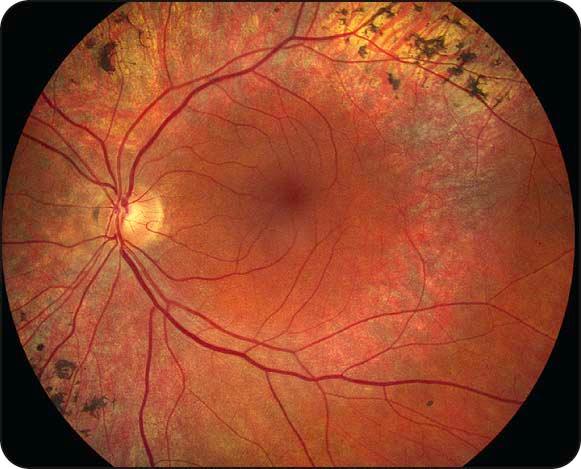
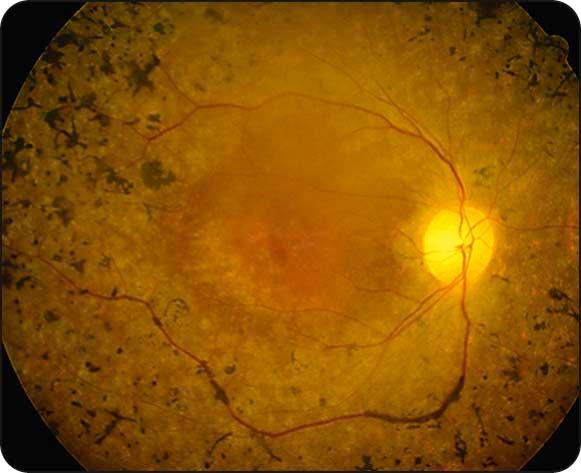
Electroretinogram (ERG): reduced scotopic rod and combined responses in early disease; later, photopic responses reduce and eventually the ERG is extinguished.
Electro-oculogram (EOG): subnormal with an absence of the light rise.
Perimetry: small mid-peripheral scotomas gradually coalesce, leaving a tiny central island that may eventually be extinguished.
Ocular associations: (a) posterior subcapsular cataracts, (b) open-angle glaucoma, (c) myopia, (d) keratoconus, (e) Coats disease, and (f) disc drusen.
Atypical RP: either closely related to typical RP or representing incomplete forms of the disease (e.g. cone–rod dystrophy, sector RP, RP sine pigmento).
Treatment: associations such as cataract and glaucoma are treated as appropriate; CMO may respond to systemic acetazolamide.
RP, often atypical, may be associated with the following:
Bassen–Kornzweig syndrome (abetalipoproteinaemia): AR lipoprotein abnormality with malabsorption of fat-soluble vitamins causing failure to thrive followed by severe spinocerebellar ataxia; blood microscopy shows ‘thorny’ red cells (acanthocytosis). Treatment with large vitamin doses may prevent visual loss.
Refsum disease: AR enzyme deficiency resulting in phytanic acid accumulation; there are distinct infantile and adult types. Early detection and a diet low in phytanic acid can arrest progression of the potentially severe neurological and other features.
Kearns–Sayre syndrome: mitochondrial inheritance; chronic progressive external ophthalmoplegia associated with systemic problems (see Chapter 19 ).
Bardet–Biedl syndrome: genetically heterogeneous condition with systemic features including mental handicap; fundus often shows a bull's-eye maculopathy due to cone–rod dystrophy.
Usher syndrome: AR, but genetically heterogeneous; accounts for approximately 5% of all cases of profound deafness in children, and approximately half of all cases of combined deafness and blindness.
Definition: a usually sporadic dystrophy predominantly affecting the cone system. In some cases, there is no evidence of rod dysfunction, whereas in others rod dysfunction subsequently develops but cone deficiency still predominates (cone–rod dystrophy).
Diagnosis
Presentation: in 2nd to 4th decades with impaired central and colour vision.
Signs: the macula may show (a) virtually normal appearance, (b) nonspecific pigmentary changes, or (c) bull's-eye configuration ( Table 15.1 , Fig. 15.3 ); geographic atrophy subsequently ensues ( Fig. 15.4 ), with VA of 6/60 or worse.
|
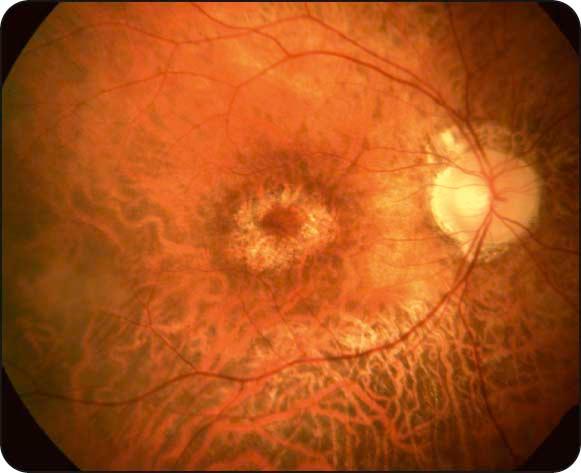
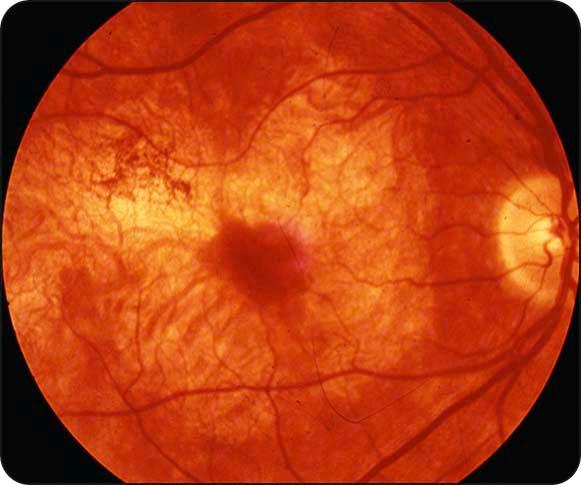
ERG: photopic responses are subnormal or unrecordable and flicker fusion frequency is reduced, but rod responses are preserved until late.
EOG: normal to subnormal.
Definition: severe AR condition that is the most common genetic cause of visual impairment in children.
Diagnosis
Presentation: perinatal blindness associated with nystagmus or roving eye movements.
Signs: (a) absent or sluggish pupillary light reflexes; (b) mild pigmentary retinopathy may be seen initially ( Fig. 15.5 ), followed by (c) coloboma-like fundus lesions, optic atrophy, severe arteriolar narrowing, and macular pigmentation.
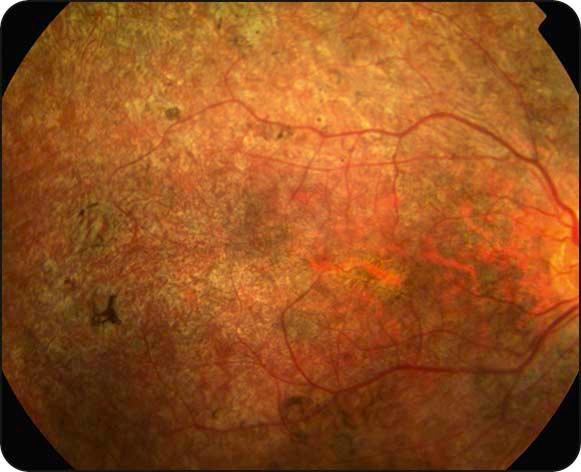
ERG: usually nonrecordable even in early cases.
‘ Oculodigital syndrome’: constant rubbing of the eyes causing enophthalmos is characteristic ( Fig. 15.6 ).
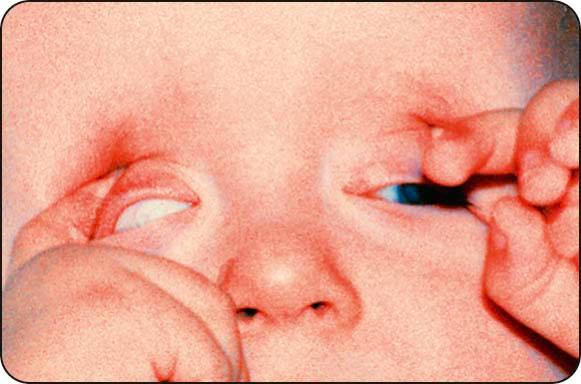
Definition: Stargardt disease and fundus flavimaculatus (FFM) are variants of the same disease, characterized by diffuse accumulation of lipofuscin within the RPE. Inheritance is AR, and mutations in at least three different genes have been identified; symptoms may be disproportionate to visible fundus changes.
Diagnosis
Presentation: in the 1st and 2nd decades, occasionally later, with gradual impairment of central vision; some patients may remain asymptomatic until late, especially with predominantly peripheral changes (FFM pattern).
Maculopathy: (a) the macula may be normal initially and then show nonspecific mottling or an oval ‘snail-slime’ or ‘beaten-bronze’ appearance ( Fig. 15.7 ), with (b) progression to geographic atrophy or bull's-eye maculopathy.
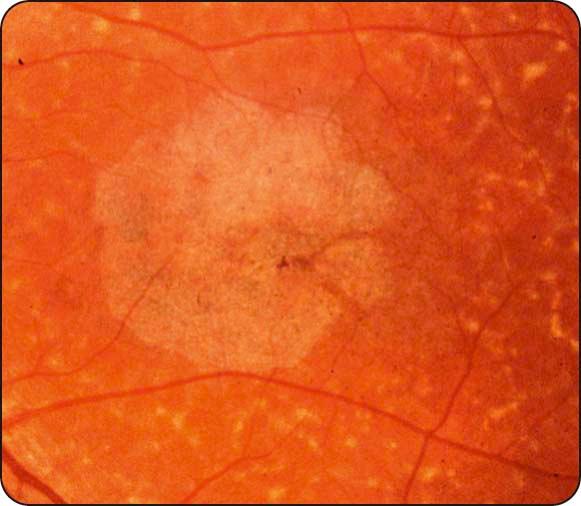
Flecks: yellow-white lesions at the level of the RPE, of various size and shape such as round, oval, or pisciform (fish-shaped), at the posterior pole exclusively ( Fig. 15.8 ) or extending to the mid-periphery ( Fig. 15.9 ).
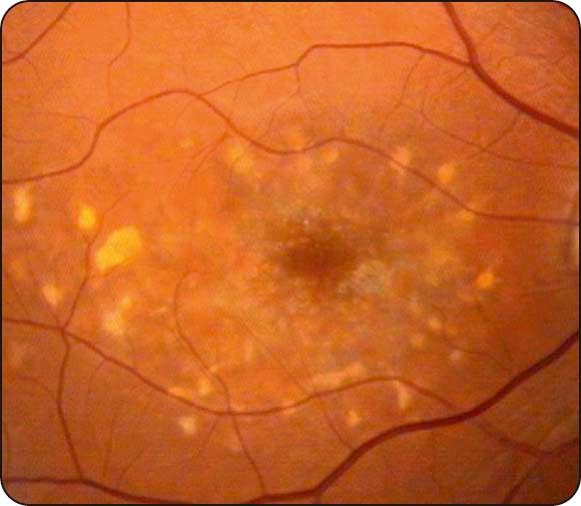
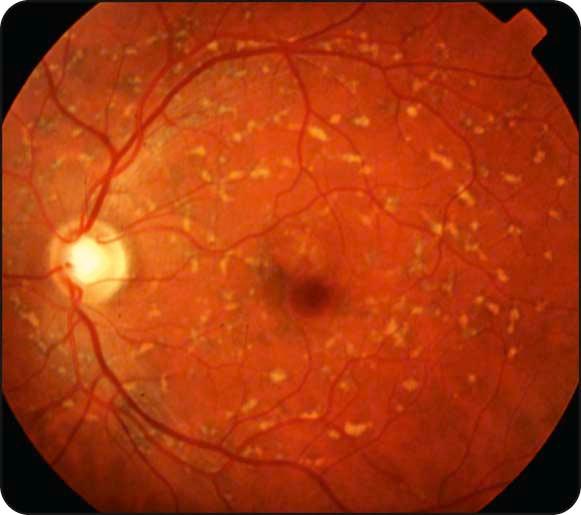
Course: VA tends to stabilize at approximately 6/60; patients with only flecks have a better prognosis.
ERG: photopic is normal to subnormal and scotopic normal.
EOG: subnormal in advanced cases.
FA: (a) maculopathy shows central hyperfluorescence; (b) generalized ‘dark choroid’ with prominence of the retinal vasculature is classic ( Fig. 15.10 ); (c) fresh flecks show early hypofluorescence, and old flecks show RPE window defects ( Fig. 15.11 ).
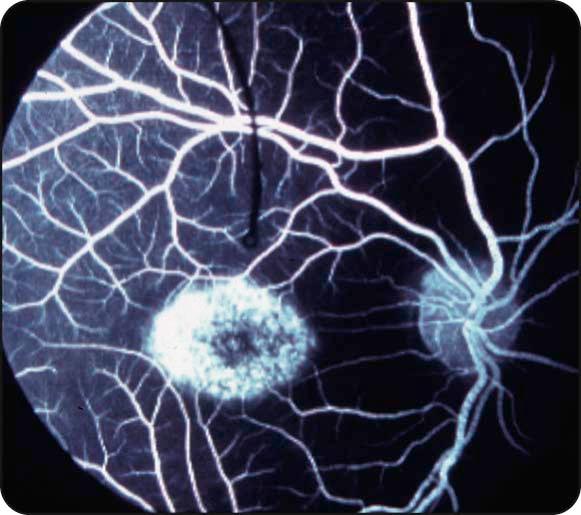
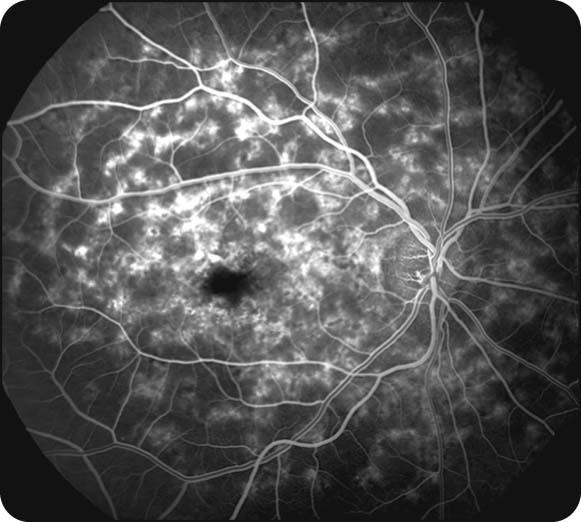
Definition: group of disorders characterized by infantile-onset nyctalopia and nonprogressive retinal dysfunction; the fundus appearance may be normal or abnormal.
Diagnosis
With normal fundus: types range from complete absence of rod function with normal cone function, to mixed impairment.
With abnormal fundus: (a) Oguchi disease, in which the fundus has an unusual golden-yellow colour when light-adapted, becoming normal after prolonged dark adaptation (Mizuo phenomenon), and (b) fundus albipunctatus, an innocuous AR or AD condition in which there are numerous tiny yellow-white spots sparing the fovea and extending to the periphery ( Fig. 15.12 ).
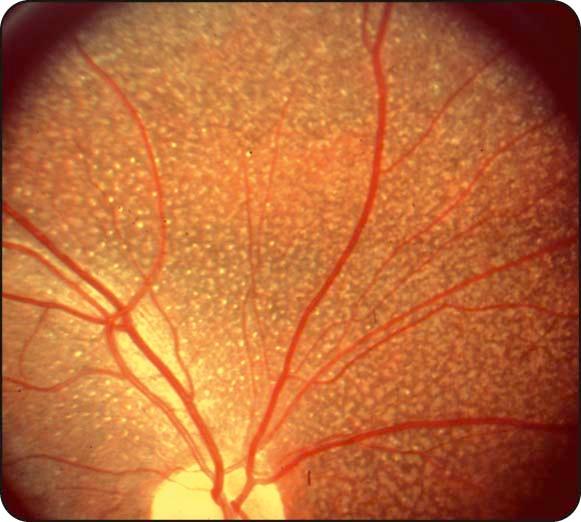
Become a Clinical Tree membership for Full access and enjoy Unlimited articles
If you are a member. Log in here